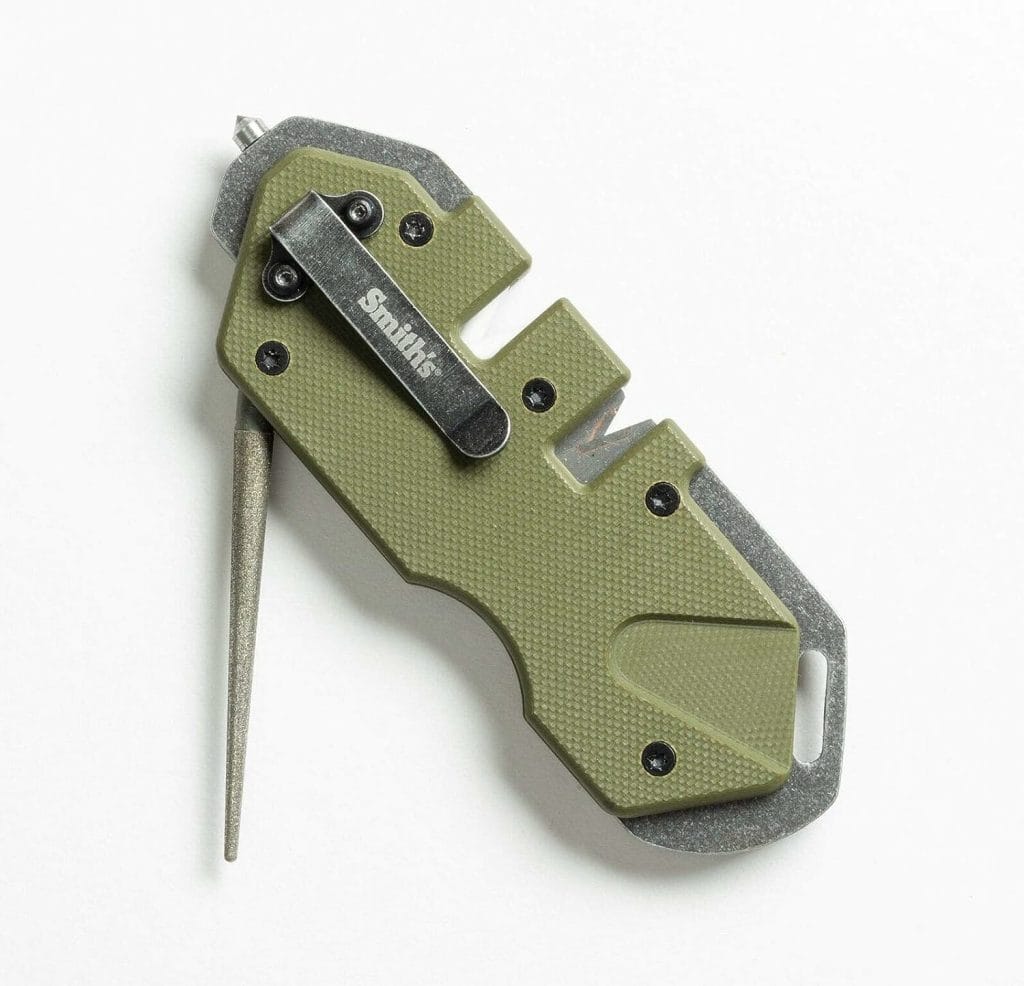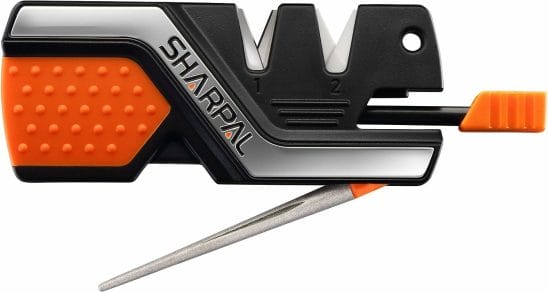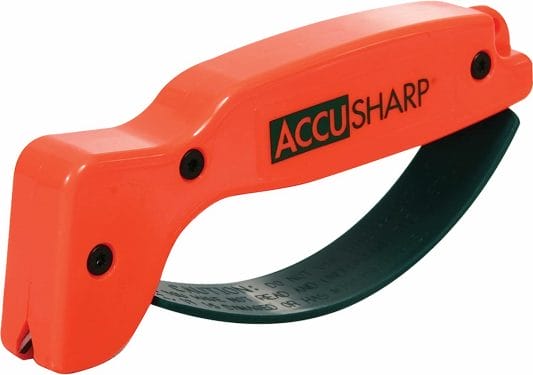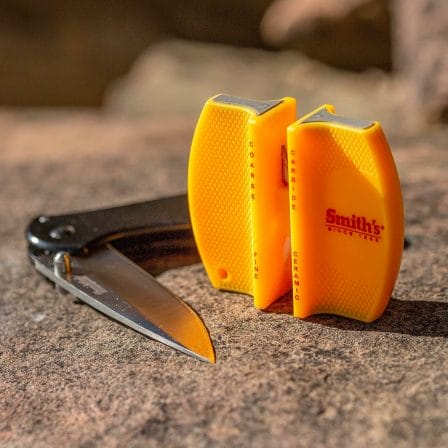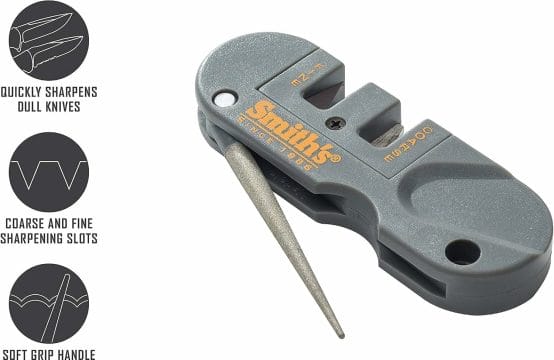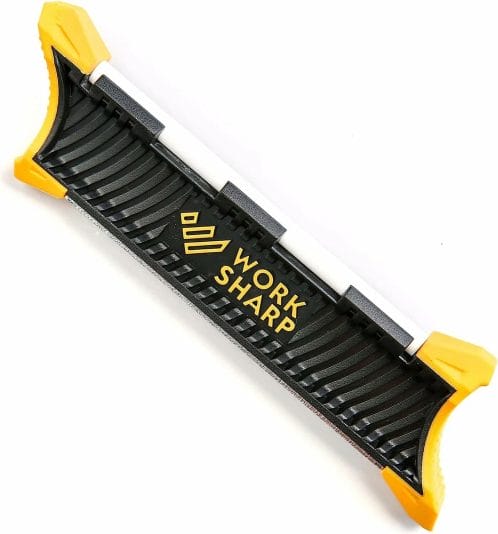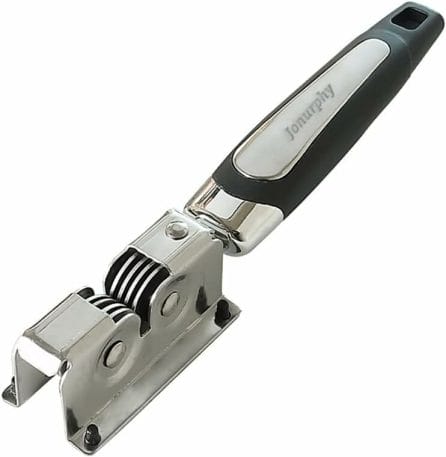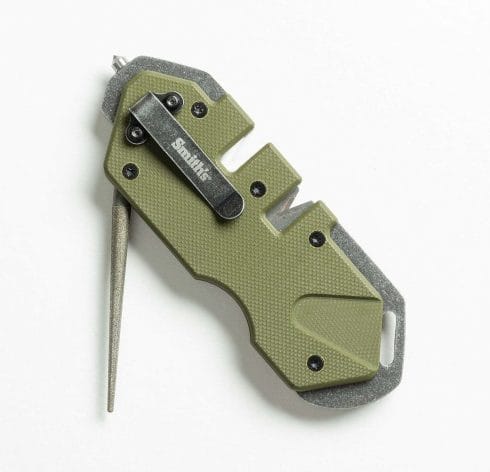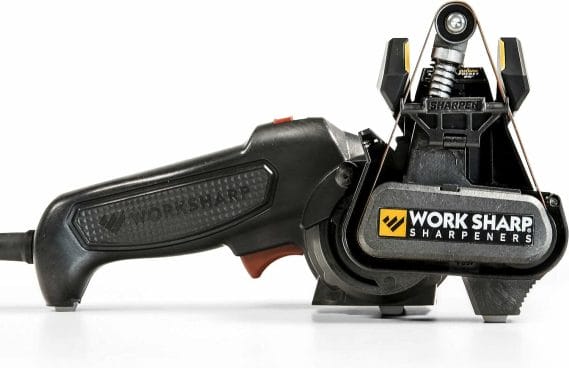Whether you’re a seasoned hunter or just starting out on your hunting journey, one thing is for certain – having a sharp hunting knife is essential. A sharp knife not only makes field dressing and skinning tasks more efficient but also ensures your safety. For beginner hunters, finding the right hunting knife sharpener can be overwhelming due to the variety of options available. In this guide, we’ll walk you through the key aspects to consider and introduce you to the best hunting knife sharpeners that are perfect for beginners.
Introduction
A hunting knife is more than just a tool; it’s an extension of a hunter’s skills and capabilities. However, even the best hunting knives will eventually lose their edge after repeated use. This is where a reliable hunting knife sharpener comes into play. As a beginner, choosing the right sharpener can significantly impact your hunting experience.
The Importance of a Sharp Hunting Knife
A sharp hunting knife is not only safer to use but also more effective in carrying out various tasks. Dull knives can lead to accidents due to the increased force needed to cut, while sharp knives make clean cuts, reducing the risk of slipping. Additionally, a sharp knife makes the field dressing process quicker and more precise, ensuring the quality of the meat isn’t compromised.
Types of Knife Sharpeners
There are several types of hunting knife sharpeners available, each with its own set of advantages and disadvantages.
Electric Knife Sharpeners
Electric knife sharpeners are known for their speed and convenience. They use rotating abrasive wheels to quickly sharpen the blade. However, they might require a learning curve to achieve the right angle consistently.
Manual Knife Sharpeners
Manual sharpeners are versatile and come in various designs, including pull-through sharpeners and sharpening rods. They offer more control over the sharpening process but require some practice to master.
Sharpening Stones
Sharpening stones, also known as whetstones, are traditional and highly effective. They require more skill but offer precise control over the sharpening angle. They are a great option for those willing to invest time in honing their sharpening skills.
Factors to Consider When Choosing a Knife Sharpener
Before purchasing a hunting knife sharpener, consider the following factors:
Ease of Use
As a beginner, opt for a sharpener that’s easy to use and doesn’t require intricate techniques.
Angle Guides
Look for a sharpener with built-in angle guides to help maintain a consistent sharpening angle.
Abrasiveness
Different sharpeners offer different levels of abrasiveness. Coarse abrasives are suitable for reshaping the blade, while finer abrasives refine the edge.
Durability
Invest in a sharpener made from quality materials that can withstand regular use.
Here are the details of the top 10 best hunting knife sharpeners for beginners
1. SHARPAL 101N 6-In-1 Pocket Knife Sharpener & Survival Tool
The SHARPAL 101N 6-In-1 Pocket Knife Sharpener & Survival Tool is a versatile and compact gadget designed for outdoor enthusiasts. This tool combines six essential functions into one, serving as a knife sharpener, fire starter, emergency whistle, diamond-coated rod, and tapered diamond rod. Its compact size makes it easy to carry in your pocket or backpack, ensuring you’re prepared for various situations. The built-in materials offer durability and reliability, making it an ideal companion for camping, hiking, and other outdoor activities. With its multifunctional design, the SHARPAL 101N is a practical and convenient tool for both sharpening and survival needs.
2. Work Sharp Guided Field Sharpener, Compact Travel Knife Sharpener Tool
The Work Sharp Guided Field Sharpener is a compact and essential tool for maintaining knife sharpness during travels. Designed with precision, it offers a versatile solution for outdoor enthusiasts. This sharpener includes five abrasive steps, from coarse to fine, ensuring an optimal edge on knives, fish hooks, and tools. Its compact size and durability make it a reliable companion for camping, hunting, or any adventure. The built-in angle guides simplify the sharpening process, even for beginners. With the Work Sharp Guided Field Sharpener, keeping your blades razor-sharp on the go becomes effortless, enhancing the efficiency and performance of your tools.
3. AccuSharp Hunting Knife & Tool Sharpener
The AccuSharp Knife & Tool Sharpener in vibrant orange is a must-have for anyone seeking a convenient and effective sharpening solution. Specifically designed for pocket knives, hunting knives, and a wide range of tools, this sharpener offers a quick and hassle-free way to restore blade sharpness. The unique design features a diamond-honed tungsten carbide sharpening blade that swiftly sharpens edges with a few easy strokes.
What sets the AccuSharp apart is its simplicity and durability. It doesn’t require any intricate adjustments or specialized skills. The ergonomic handle ensures a secure grip while sharpening, enhancing safety and precision. The compact size and lightweight build make it an excellent choice for outdoor adventures, allowing you to maintain your tools’ performance on the go. Whether you’re an avid hunter, camper, or someone who values sharp tools, the AccuSharp Knife & Tool Sharpener is a reliable and efficient companion that ensures your blades are always ready for action.
4. Smith’s CCKS 2-Step Hunting Knife Sharpener
The Smith’s CCKS 2-Step Knife Sharpener in bright yellow is a user-friendly and effective tool for achieving razor-sharp edges on your knives. This compact sharpener is designed with simplicity in mind, offering a two-step process for sharpening blades to perfection. The preset coarse and fine slots cater to different levels of blade dullness, making the sharpening process hassle-free.
The coarse slot, with its carbide blades, quickly restores the edge of the knife, while the fine slot, equipped with ceramic rods, hones and polishes it to a finer finish. The non-slip rubber base provides stability during use, ensuring safety and accuracy. Its vibrant yellow color adds visibility and a touch of flair to the tool.
The Smith’s CCKS 2-Step Knife Sharpener is an ideal choice for those who desire convenience and reliability. Whether you’re a seasoned chef, outdoor enthusiast, or someone who values sharp tools, this sharpener ensures your knives are maintained at their best, ready to tackle any cutting task with ease.
5. Smith’s PP1 Pocket Pal Knife Sharpener
The Smith’s PP1 Pocket Pal Knife Sharpener is a versatile and compact tool designed to keep your blades in optimal condition, whether you’re out in the wild or at home. With its handheld convenience, this sharpener is a must-have for outdoor enthusiasts, hunters, and anyone seeking a portable sharpening solution.
Featuring a combination of preset carbide and ceramic stone sharpeners, the Pocket Pal effectively restores dull edges with the coarse carbide slot and refines them to a fine finish with the ceramic slot. The fold-out diamond-coated rod adds further functionality, catering to serrated edges, hooks, and other specialized blades.
The sharpener’s lightweight and foldable design makes it easy to carry in pockets, toolkits, or backpacks. Its rugged build ensures durability in demanding outdoor environments. Whether you need to restore a hunting knife, a pocket knife, or any blade on the go, the Smith’s PP1 Pocket Pal Knife Sharpener offers a compact and efficient solution to keep your tools sharp and ready for action.
6. Work Sharp WSGPS-W Pocket Knife Sharpener
The Work Sharp WSGPS-W Pocket Knife Sharpener is a compact and innovative tool designed to keep your pocket knives in prime cutting condition. With its sleek and portable design, this sharpener is a practical solution for those who demand precision on the go.
Equipped with a diamond plate for coarse sharpening and ceramic rods for fine honing, the WSGPS-W offers a dual-stage sharpening process that caters to a variety of blade types. The diamond plate efficiently reshapes and rejuvenates dull edges, while the ceramic rods provide a polished finish for optimal cutting performance.
The sharpener’s fold-out design ensures easy storage and handling, and its non-slip rubber grip adds stability during use. This pocket-sized tool is an ideal companion for outdoor adventures, ensuring that your knives are always in top-notch condition. Whether you’re a camper, hiker, or simply someone who values sharp tools, the Work Sharp WSGPS-W Pocket Knife Sharpener is a versatile and efficient solution to maintain your blades’ sharpness wherever you are.
7. Jonurphy Kitchen Knife Sharpener
The Jonurphy Knife Sharpener is a versatile and user-friendly kitchen tool designed to bring life back to your dull knives. With its innovative rotating steel wheel sharpening discs, this manual sharpener offers a simple and effective way to sharpen your kitchen blades at home.
The sharpening process is made easy with rotating discs that provide consistent and precise sharpening angles. The tool is suitable for various types of knives, making it an essential addition to any kitchen. Its compact and ergonomic design ensures comfortable use, allowing you to restore the sharpness of your knives effortlessly.
Whether you’re a seasoned chef or a home cook, the Jonurphy Knife Sharpener is a practical solution to maintain the efficiency and longevity of your knives. With its rotating steel wheel technology and user-friendly approach, this manual sharpening tool is a valuable asset for anyone who values sharp and effective cutting tools in their kitchen.
8. Smith’s 50981 Pocket Pal Tactical Knife Sharpener
The Smith’s 50981 Pocket Pal Tactical Knife Sharpener in OD Green is a reliable and versatile tool designed for outdoor enthusiasts and tactical users. With its 2-stage sharpening system and integrated diamond sharpening rod, this compact sharpener ensures your knives are always ready for action.
Featuring a coarse carbide slot for initial sharpening and a fine ceramic slot for honing, the Pocket Pal Tactical Sharpener accommodates various blade types. The fold-out diamond-coated rod is particularly useful for serrated edges, hooks, and specialty blades.
Its thoughtful design includes a pocket clip for easy carrying, making it a perfect companion for outdoor adventures, hunting, and tactical situations. The OD Green color adds a touch of camouflage, blending well with outdoor gear. Lightweight and compact, this sharpener caters to those who demand precision and reliability from their tools, ensuring that your knives remain sharp and efficient when you need them the most.
9. AccuSharp Knife & Tool Sharpener 2 Pack
The AccuSharp Knife & Tool Sharpener 2 Pack offers exceptional value for anyone seeking a versatile and effective sharpening solution. This set of two sharpeners is designed to cater to a wide range of blades, including kitchen knives, pocket knives, serrated blades, axes, and machetes.
Utilizing diamond-honed tungsten carbide sharpening blades, these sharpeners are capable of not only sharpening but also restoring and repairing worn edges. The two-stage sharpening process includes coarse and fine slots, ensuring optimal results for various levels of blade dullness.
Ideal for both indoor and outdoor use, these sharpeners are lightweight, compact, and easily portable. They bring new life to your blades, providing razor-sharp edges that enhance performance and safety. With the AccuSharp Knife & Tool Sharpener 2 Pack, you get a versatile and efficient sharpening solution that’s perfect for a wide array of cutting tools, all in one convenient set.
10. Knife & Tool Sharpener Mk.2 – Professional Electric Knife Sharpener
The Knife & Tool Sharpener Mk.2 is a cutting-edge professional electric sharpener designed to elevate your blade maintenance experience. Operating at 120 volts, this sharpener offers effortless and precise sharpening for a variety of knives and tools.
Equipped with advanced sharpening technology, the Mk.2 boasts features that cater to professionals and enthusiasts alike. Its motorized system ensures consistent and accurate sharpening, saving you time and effort. With adjustable sharpening angles and grit options, it accommodates different blade types and requirements.
Perfect for sharpening kitchen knives, outdoor blades, and various tools, the Knife & Tool Sharpener Mk.2 combines efficiency with convenience. Its user-friendly design makes it accessible for users of all skill levels. Whether you’re a culinary expert or a hobbyist, this electric sharpener enhances your tools’ performance, ensuring precision cuts and extended tool lifespans. Upgrade your sharpening routine with the Knife & Tool Sharpener Mk.2 and experience professional-grade results with ease.
How to Sharpen a Hunting Knife Step by Step
-
Inspect the Blade: Examine the blade for nicks or damage before sharpening.
-
Choose the Angle: Use the built-in angle guide or determine the appropriate angle for your knife.
-
Start Sharpening: Follow the sharpener’s instructions to begin sharpening the blade.
-
Alternate Sides: Ensure even sharpening by alternating between sides regularly.
-
Hone the Edge: Finish by honing the edge on a finer abrasive for a polished finish.
Tips for Maintaining Your Hunting Knife
- Regularly clean your knife to prevent buildup.
- Store your knife in a dry place to avoid corrosion.
- Hone your knife’s edge before each hunting trip.
Conclusion
A well-sharpened hunting knife is a fundamental tool for any beginner hunter. With the right knowledge and equipment, you can keep your knife in top condition, enhancing your hunting experience and ensuring your safety. Explore the range of hunting knife sharpeners available and choose one that best suits your skill level and preferences.
FAQs
Q1: Is it better to sharpen a knife manually or with an electric sharpener?
The choice between manual and electric knife sharpening depends on your preferences, skill level, and the type of results you’re aiming for.
Manual Sharpening:
- Control: Manual sharpening allows for greater control over the sharpening process. You can adjust the pressure and angle according to your blade’s needs.
- Skill: It requires some practice to master the technique, especially maintaining consistent angles.
- Precision: Manual sharpening can achieve very precise edge angles, making it suitable for specialty knives and exacting tasks.
- Portability: Manual sharpeners are often compact and portable, making them convenient for outdoor activities.
Electric Sharpening:
- Ease and Speed: Electric sharpeners are user-friendly and efficient. They require less skill and effort, making them suitable for beginners.
- Consistency: Electric sharpeners provide consistent results, ensuring uniform sharpening across the blade.
- Angle Guides: Many electric sharpeners come with built-in angle guides, making it easier to maintain the correct sharpening angle.
- Versatility: Some electric sharpeners offer multiple sharpening stages for both coarse and fine sharpening, accommodating a range of blade conditions.
- Time-Saving: Electric sharpeners are quicker than manual methods, making them convenient for busy kitchens.
Ultimately, the best choice depends on your comfort level, the tools you have available, and the specific needs of your knives. Enthusiasts who value precision and control might prefer manual sharpening, while those seeking speed and convenience may lean towards electric sharpeners. It’s important to choose a method that aligns with your skill level and meets your sharpening goals.
Q2: How often should I sharpen my hunting knife?
The frequency of sharpening your hunting knife depends on factors like how often you use it, the tasks you perform with it, and the type of steel the blade is made from. As a general guideline:
-
Usage Frequency: If you use your hunting knife regularly, you might need to touch up the edge more often. If it’s used infrequently, you can go longer between sharpenings.
-
Task Intensity: If your hunting knife is subjected to tasks like cutting through bone or thick materials, it might require more frequent sharpening.
-
Steel Type: Different knife steels retain their edges differently. Harder steels tend to hold their edge longer, while softer steels might need more frequent touch-ups.
-
Visual and Performance Indicators: If you notice that the knife is struggling to cut smoothly, or if you see visible signs of dullness like tearing instead of slicing, it’s time to sharpen.
As a general rule of thumb, many hunters and outdoor enthusiasts sharpen their hunting knives after every outing or hunting trip. This helps maintain optimal performance and ensures the knife is ready for use when needed. It’s better to maintain a sharp edge rather than letting it become significantly dull, as restoring a very dull blade can require more effort and time.
Remember that using the right sharpening technique and tools is important. Whether you choose a manual or electric sharpener, follow the manufacturer’s guidelines and maintain consistent angle control for the best results.
Q3: Can I use the same sharpener for different types of knives?
Yes, you can often use the same sharpener for different types of knives, but it’s important to consider a few factors:
-
Sharpening Angle: Different knives have varying blade angles that need to be maintained during sharpening. If your sharpener has adjustable angle settings or guides, you can use it for a variety of knives. However, some knives, like Japanese-style knives, might have more specialized angles that require specific sharpening tools.
-
Sharpening Stages: Some sharpeners offer multiple stages for coarse and fine sharpening. This versatility allows you to use the same sharpener for different levels of blade dullness.
-
Blade Material: Different knives might be made from various types of steel with varying hardness. Check if your sharpener is suitable for the type of steel your knives are made from. Harder steels might require diamond-coated sharpeners, while softer steels might work well with standard abrasive materials.
-
Specialty Blades: If you have knives with serrated edges or specialty blades (like hooks), you might need a sharpener with specific features like serrated edge sharpening or a diamond-coated rod.
-
Consistency: Using the same sharpener consistently can help you maintain a consistent edge on all your knives.
Always read the manufacturer’s instructions and recommendations for your specific sharpener. While many sharpeners are designed to be versatile, understanding your knives and their unique requirements will help you achieve the best results and prolong the life of your blades. If you have a collection of high-end or specialty knives, you might also consider investing in sharpening tools that cater to their specific needs.
Q4: What’s the difference between honing and sharpening?
Honing and sharpening are two distinct processes in maintaining the edge of a blade, such as a knife. They serve different purposes and are often confused, but understanding their differences is crucial for proper knife care:
Sharpening:
- Purpose: Sharpening is the process of physically removing material from the blade to create a new, sharp edge. It’s necessary when the blade becomes dull or the edge has significant wear.
- Method: Sharpening involves using abrasive tools like sharpening stones, rods, or electric sharpeners. These tools grind away a small amount of metal, shaping the edge into a more acute angle.
- Frequency: Sharpening is less frequent than honing and is required when the blade’s edge has become noticeably dull or damaged.
Honing:
- Purpose: Honing is the process of realigning the microscopic edge of the blade without significantly removing metal. It’s meant to maintain the existing sharpness of the blade.
- Method: Honing is typically done using a honing rod, also known as a sharpening steel. The rod doesn’t actually sharpen the blade but helps to straighten and align the edge, restoring its sharpness.
- Frequency: Honing is a regular maintenance step and is done more frequently than sharpening. It’s recommended before or after each use to keep the blade’s edge aligned.
In summary, sharpening involves removing material to create a new edge, while honing involves realigning the existing edge without removing much metal. Both processes are essential for maintaining a knife’s performance. Regular honing can extend the time between sharpenings and ensure that your knives stay sharp and effective.
Q5: Are there any safety precautions I should take when sharpening a knife?
Absolutely, sharpening a knife requires careful attention to safety to prevent accidents and injuries. Here are some important safety precautions to keep in mind:
-
Wear Safety Gear: Consider wearing safety goggles or protective glasses to shield your eyes from any metal particles that might come off during sharpening.
-
Secure Work Surface: Make sure your sharpening setup is stable and secure. A slippery surface can lead to accidents.
-
Firm Grip: Hold the knife securely to maintain control while sharpening. A slip can result in injury.
-
Proper Tool Handling: If you’re using a manual sharpener or sharpening stone, follow the manufacturer’s instructions for safe tool handling.
-
Sharpen Away from the Body: Always direct the knife away from your body while sharpening to avoid accidentally cutting yourself.
-
Consistent Pressure: Apply consistent, gentle pressure while sharpening. Avoid using excessive force, as it can result in uneven sharpening or slip-ups.
-
Maintain Angle: If using a manual sharpener or sharpening stone, maintain a consistent angle as instructed by the manufacturer. This ensures effective sharpening and reduces the risk of accidents.
-
Serrated Blades: When sharpening serrated knives, use specialized tools designed for serrated edges. Be cautious as the pointed teeth can be sharp.
-
Check Knife Stability: Some sharpeners have suction cups or bases for stability. Ensure the sharpener is secure and won’t move during use.
-
Keep Fingers Clear: Be mindful of your fingers, especially when using tools like honing rods or sharpening systems. Keep your fingers behind the edge of the blade.
-
Work in a Well-lit Area: Adequate lighting helps you see what you’re doing and prevents accidents.
-
Proper Storage: After sharpening, store your tools safely to prevent accidental contact with the sharpened edges.
Remember, practice makes perfect. If you’re new to sharpening, take your time, be patient, and prioritize safety. Following these precautions will help you sharpen your knives effectively while minimizing the risk of accidents.
